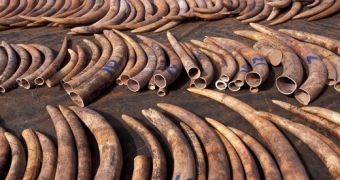Only recently, authorities in Hong Kong, together with officials working for the Guandong Customs, made significant progress in terms of putting an end to the illegal ivory trade. Thus, they have confiscated as many as 1,209 elephant tusks.
Apparently, the tusks came from Kenya and Tanzania, and were broken down into two massive illegal shipments. Once put on a scale, it was found that the tusks amounted to 3,813 kilograms (about 8,400 pounds).
Seeing how your run-off-the-mill elephant displays too such tusks, one need not be a specialist to realize that this much ivory most likely came from more than 600 slaughtered animals.
Due to the fact that African elephants are presently listed as a vulnerable species under the IUCN Red List, it goes without saying that putting an end to activities such as poaching and the illegal ivory trade is of utmost importance.
Authorities claim that the 1,209 tusks they have succeeded in confiscating thanks to information leaked by the Guandong Customs are worth about $3.4 million (€2.6 million) on the black market.
This means that, from an economic standpoint, these two confiscated shipments are the largest bust of ivory made thus far in Hong Kong's history, Mongabay says.
It seems that 7 people have been arrested and are soon to be tried for their involvement in killing these animals and trying to illegally sell their tusks on illegal markets worldwide.
As we have previously reported, noteworthy amounts of the ivory that ends up on the illegal market are used to manufacture religious trinkets.
Because of this, it is crucial that both the political and the spiritual leaders of various communities work together towards ending poaching and keeping this species from becoming extinct.
“Today’s poaching gangs are sophisticated, global and vicious. They are invading our countries, not only slaughtering our wildlife but also killing rangers, and terrorizing communities,” Basile Yopo from the World Wildlife Fund explained at one point.

 14 DAY TRIAL //
14 DAY TRIAL //